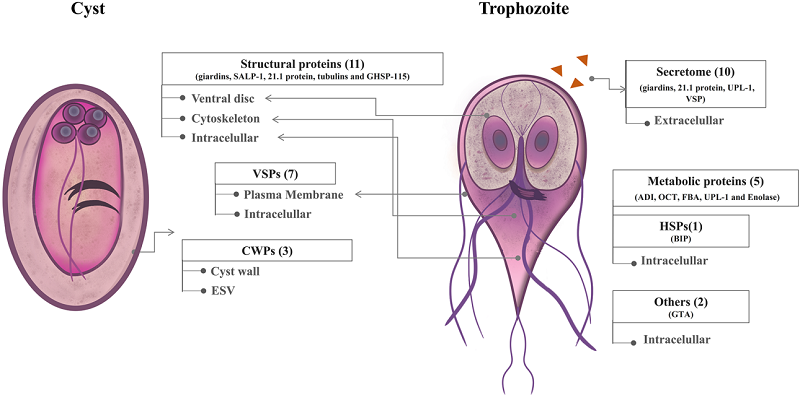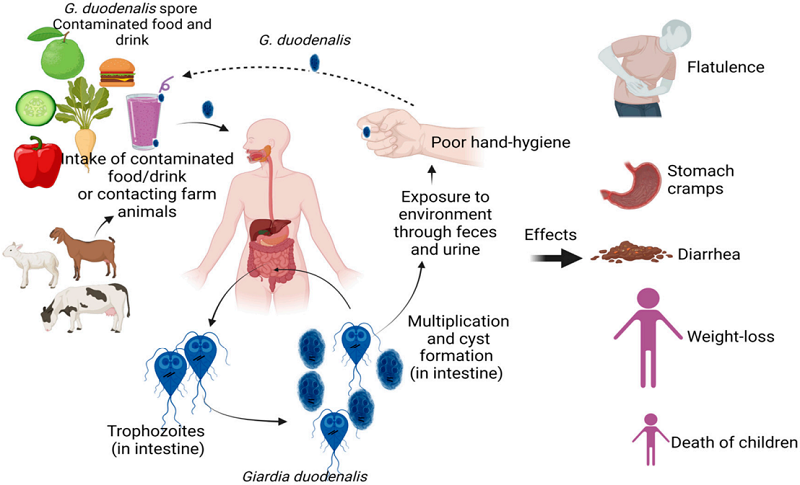As a world-leading service provider of antibody development, Creative Biolabs has established an array of in vitro diagnostic (IVD) antibody development services targeting pathogens of infectious diseases. Especially, we offer IVD antibody development services for Giardia Lamblia. Our scientists and technical experts specialized in IVD antibody development are pleased to assist you in your studies with professional technical support.
About Giardia Lamblia
Giardia lamblia, also referred to as Giardia intestinalis or Giardia duodenalis, is microscopic, flagellated parasite which that colonizes and reproduces in the small intestine and causes giardiasis. It attaches to the epithelium through a ventral adhesive disc, and reproduces by binary fission. The trophozoites of Giardia lamblia are anaerobes andabsorb nutrients from the lumen of the small intestine. It relies on glucose as the main energy source and breaks glucose down into acetate, ethanol and carbon dioxide. Moreover, it can also utilize arginine as its energy source. Giardia lamblia is protected by an outer shell which ensures its survival outside the host for a long time and makes it tolerant to chlorine disinfection. The cyst of Giardia Lamblia can survive for weeks to months in cold water such as the contaminated wells and water systems, especially in those stagnant water sources.
 Fig.1 The cellular localization of immunogenic proteins of Giardia Lamblia.1
Fig.1 The cellular localization of immunogenic proteins of Giardia Lamblia.1
Giardia Lamblia in Gastrointestinal Disease
Giardia Lamblia infection can occur by ingesting dormant microbial cysts in contaminated water or food, or by the fecal–oral transmission, and can cause a gastrointestinal disease called giardiasis in small intestine. Giardia lamblia can infect humans, and is also one of the most common parasites infecting birds, cats and dogs. There are also other mammalian hosts including dozens of species such as sheep, goats and cattle. While Giardia lamblia can be spread in several different ways, water (drinking water as well as recreational water) is the most common route of transmission. Giardia lamblia does not spread by the blood, nor does it spread to other parts of the gastrointestinal tract. Thus, it remains confined to the small intestine lumen. The main symptom of Giardia Lamblia infection is diarrhea, gas, stomach or abdominal cramps, nausea/vomiting, and dehydration. In some cases, individuals infected with Giardia Lamblia have no symptoms.
 Fig.2 Life cycle and infection of Giardia duodenalis.2
Fig.2 Life cycle and infection of Giardia duodenalis.2
Correlation of Giardia Lamblia and Food & Water
Recently, new recognition of pathologies beyond the regular symptoms of infection which include chronic fatigue, postinfectious irritable bowel syndrome, and particularly, in early childhood, poor cognitive function and failure to thrive led to a greater appreciation of the public health consequences of giardiasis. In addition, to transmit by the fecal-oral route, the most common way to get giardiasis is to drink water that contains giardia from animal feces, diapers, and agricultural runoff. Contaminated water can be in swimming pools, spas, and bodies of water, such as lakes. What's more, poor hygiene when handling food or eating produce rinsed in contaminated water can also allow the parasite to spread.
Giardia Lamblia Antibody Development Services
Nowadays, IVDs are widely applied to perform tests on samples, such as blood, urine, and tissues, contributing to infection detection, disease diagnosis, and drug therapy monitoring. With years of experience in antibody development, technicians and specialists at Creative Biolabs can help you develop novel Giardia Lamblia antibodies. Besides antibody generation, Creative Biolabs also offers diagnostic immunoassay development services, including feasibility analysis, assay design, assay protocol establishment, assay optimization, and kit production.
Please feel free to contact us for more details.
References
- Garzon, Thania, et al. "Immunoinformatic identification of T-Cell and B-Cell epitopes from Giardia lamblia immunogenic proteins as candidates to develop peptide-based vaccines against giardiasis." Frontiers in Cellular and Infection Microbiology 11 (2021): 769446. Distributed under Open Access license CC BY 4.0, without modification.
- Sangkanu, Suthinee, et al. "Conserved Candidate Antigens and Nanoparticles to Develop Vaccine against Giardia intestinalis." Vaccines 11.1 (2022): 96. Distributed under Open Access license CC BY 4.0, without modification.
For Research Use Only.

